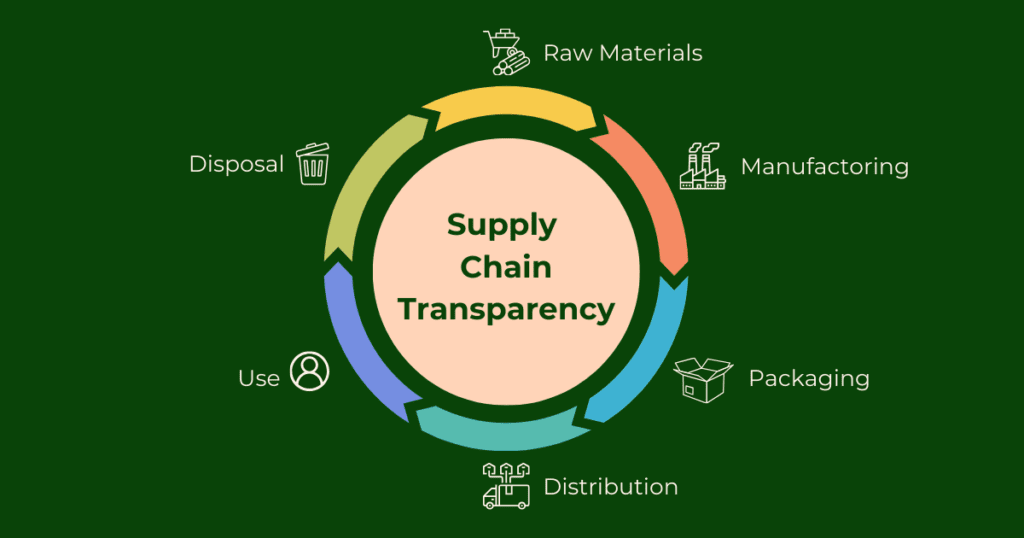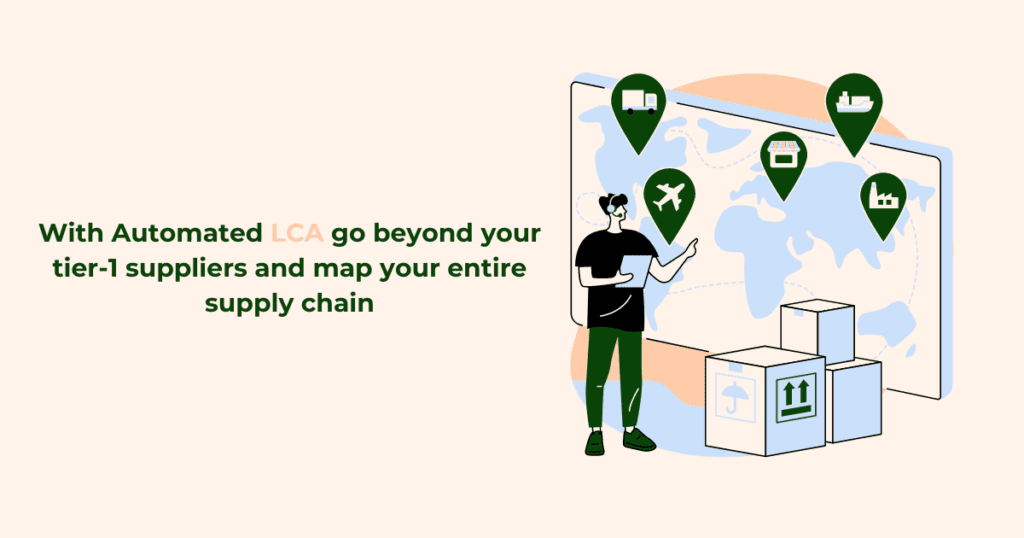Supply chain transparency explained
Do you ever wonder where your products really come from and how they are made? You’re not alone – these days consumers, the media, investors and governments are also curious. With increasingly complex global supply chains, providing this information can be tricky, but it’s necessary to meet regulatory requirements and stakeholders’ expectations.
In this blog, we demystify supply chain transparency, explore why it’s a crucial part of any company’s sustainability journey and share practical tips to improve it. We also delve into the challenges of supply chain transparency, the pivotal role technology plays in making it more accessible and how automated life cycle assessment (LCA), like Root, can be a transformative tool to improve supply chain transparency.
PUBLISHED: 14 August 2024
WRITTEN BY: Charlie Walter
Table of contents
- What is supply chain transparency?
- Supply chain visibility versus transparency
- The rise of supply chain transparency legislations
- Why is supply chain transparency so important?
- What are the barriers to achieving supply chain transparency?
- How to achieve supply chain transparency?
- Supply chain transparency tools
- Role of automated LCA in improving supply chain transparency
- How we can help
What is supply chain transparency?
Supply chain transparency is more than just a buzzword – it requires fully understanding every aspect of your supply chain. This involves understanding where your products come from and the social and environmental impact at each stage of the product’s life cycle, from raw material to finished product.
Transparency also means ensuring that every part of your supply chain meets high environmental and social sustainability standards. This practice, known as due diligence, is essential for maintaining a transparent and sustainable supply chain.
Communicating the impact of your supply chain is crucial to supply chain transparency. When you openly share this information, you build trust with your stakeholders and prove that your supply chain aligns with your commitment to sustainability.
Supply chain visibility versus transparency
Simply put, supply chain visibility is what you know internally and supply chain transparency is what you share externally.
Supply chain visibility focuses on tracking products and their sustainability impact across the supply chain for internal use. Think of it as having behind-the-scenes data on your products, like supplier locations and transport routes.
On the other hand, supply chain transparency focuses on sharing the highlights of behind-the-scenes data with the world, such as customers, investors and regulators. This involves being open about your sourcing practices, production processes and the supply chain’s environmental and social impacts.
While supply chain visibility is crucial for transparency, it’s just the start. You need visibility to gather accurate data, but supply chain transparency is where you communicate the impact of your supply chain to stakeholders, turning the data into trust and accountability.

The rise of supply chain transparency legislations
Governments worldwide are rolling out regulations that make supply chain transparency a legal obligation.
These regulations are particularly apparent in Europe.
- The EU’s Corporate Sustainability Due Diligence Directive (CSDDD) requires companies to audit their supply chain to meet human rights and environmental standards.
- Another example is the Ecodesign for Sustainable Products Regulation (ESPR), which mandates the creation of Digital Product Passports (DPPs) to improve transparency around the product’s environmental impact throughout its life cycle.
Globally, these regulations are taking centre stage.
- For example, due to forced labour concerns, the US Uyghur Forced Labour Prevention Act bans the import of goods from specific regions in China. As a result, companies need complete visibility about where their products come from.
The bottom line is that supply chain transparency is no longer a choice. Businesses must adapt to these regulations to remain compliant and avoid penalties.
Why is supply chain transparency important?
Embracing supply chain transparency offers numerous benefits, including:
- Increased Customer Loyalty: Customers tend to stick with brands they trust to source and produce goods ethically. Remember the 2013 Rana Plaza collapse in Bangladesh? It shifted consumer loyalty towards brands that could prove their supply chain transparency and commitment to ethical practices.
- Improved Stakeholder Trust: Supply chain transparency builds credibility with stakeholders like investors. Patagonia, for instance, has earned significant trust from stakeholders like consumers by being upfront about its supply chain practices and sharing detailed information on its products’ environmental and social impact.
- Regulatory Compliance: Improving and maintaining supply chain transparency is critical to meeting regulatory requirements and avoiding penalties.
- Market Differentiation: When you can verify and communicate the sustainability benefits of your products, you can stand out in the market. Companies like Unilever have positioned themselves as sustainability leaders by committing to transparent sourcing.
- Brand Reputation: Avoiding unethical practices and aligning supply chain activities with your values can safeguard and even boost your brand’s reputation. Supply chain transparency plays a critical role in this, as it is vital to avoiding incidents that tarnish your brand’s image.
What are the barriers to achieving supply chain transparency?
Achieving supply chain transparency isn’t always easy. One of the biggest hurdles is data collection. Collecting accurate data, especially for Scope 3 emissions, is tricky because it requires cooperation across multiple supplier tiers. Many companies have strong relationships with their direct suppliers, but visibility often fades beyond the first tier, making it difficult to keep track of the entire supply chain.
Another challenge is integrating advanced technologies like blockchain. While Blockchain can be revolutionary for enhancing supply chain transparency, rolling it out across global operations can be daunting due to scale, cost and technical complexity.
Supply chain transparency varies across industries. The automotive sector, for instance, has a head start with creating transparent supply chains due to existing regulations. On the other hand, the fashion industry faces more significant challenges, especially when gaining visibility at the farm level, where raw materials are sourced. Therefore, achieving transparency is more challenging in some industries than in others.
How to achieve supply chain transparency?
So, how can your company navigate these challenges and achieve supply chain transparency?
Here are some best practices to start:
- Map your supply chain: Go beyond your tier-1 suppliers and map your entire supply chain.
- Collaborate with your suppliers: Foster strong relationships with your suppliers. Promote open communication, offer support and provide incentives to encourage their participation in transparency efforts, such as responding to data requests.
- Leverage technology: Adopt technology like blockchain and the Internet of Things (IoT) to monitor your supply chain closely. These tools can create real-time data, boosting visibility. Additionally, Artificial Intelligence (AI) and machine learning can process vast amounts of data to identify inefficiencies and potential risks in your supply chain.
- Share your story: Supply chain transparency isn’t just an internal exercise – share your findings with the world. Use product labelling, impact reports, the company website and social media to communicate supply chain details to consumers and other stakeholders. This is how you move from supply chain visibility (internal) to supply chain transparency (external).

Supply chain transparency tools
Technology is making it easier to achieve supply chain transparency. Artificial Intelligence and machine learning are revolutionising how we analyse supply chain data. These tools boost efficiency and improve transparency by delivering accurate and timely insights that you can share with stakeholders.
Blockchain technology is a game-changer for supply chain transparency. Blockchain creates an unchangeable record of every transaction throughout a product’s life cycle, including information about its environmental impact. A great example of a company leveraging this technology is Circularise, which uses blockchain to develop Digital Product Passports, making it easier for companies to verify and communicate their sustainability efforts.
By embracing these technologies, businesses can enhance supply chain transparency and build trust with stakeholders through precise and reliable information.
Role of automated LCA in improving supply chain transparency
Automated Life Cycle Assessment (LCA) tools are transformative in driving supply chain transparency.
Here’s how they help:
- Automatically map supply chains: Automated LCA tools pull data from various sources to map supply chains. For example, Root uses the company’s purchase and sales orders to automatically map supply chains for thousands of products simultaneously. This gives companies a clear view of each product’s value chain, including suppliers and transport routes.
- Comprehensive environmental insights: Automated LCA tools provide detailed information about a product’s environmental impact throughout its life cycle. For example, Root provides insights into the product’s environmental impact across six key impact categories. This data helps companies make smarter sourcing, production and distribution decisions.
- Scale with ease: LCA automation allows companies to perform thousands of life cycle assessments simultaneously, efficiently handling large product portfolios. This scalability is crucial for achieving full supply chain transparency across product portfolios. Root provides granular, accurate data – empowering companies to reduce their environmental impact effectively.
How we can help
At Root, we aim to redefine the norm by making product footprints universal. Our platform conducts automated LCAs for entire product portfolios – helping businesses report effectively on regulations, avoid greenwashing and become industry leaders in sustainability.
Root partners with companies to enhance their supply chain transparency efforts. Our platform automatically maps supply chains and provides detailed environmental data, empowering businesses to improve the transparency and sustainability performance of their supply chain.
Interested to learn more? Get in touch with our team to discover how Root can help you achieve compliance and drive sustainable growth.
